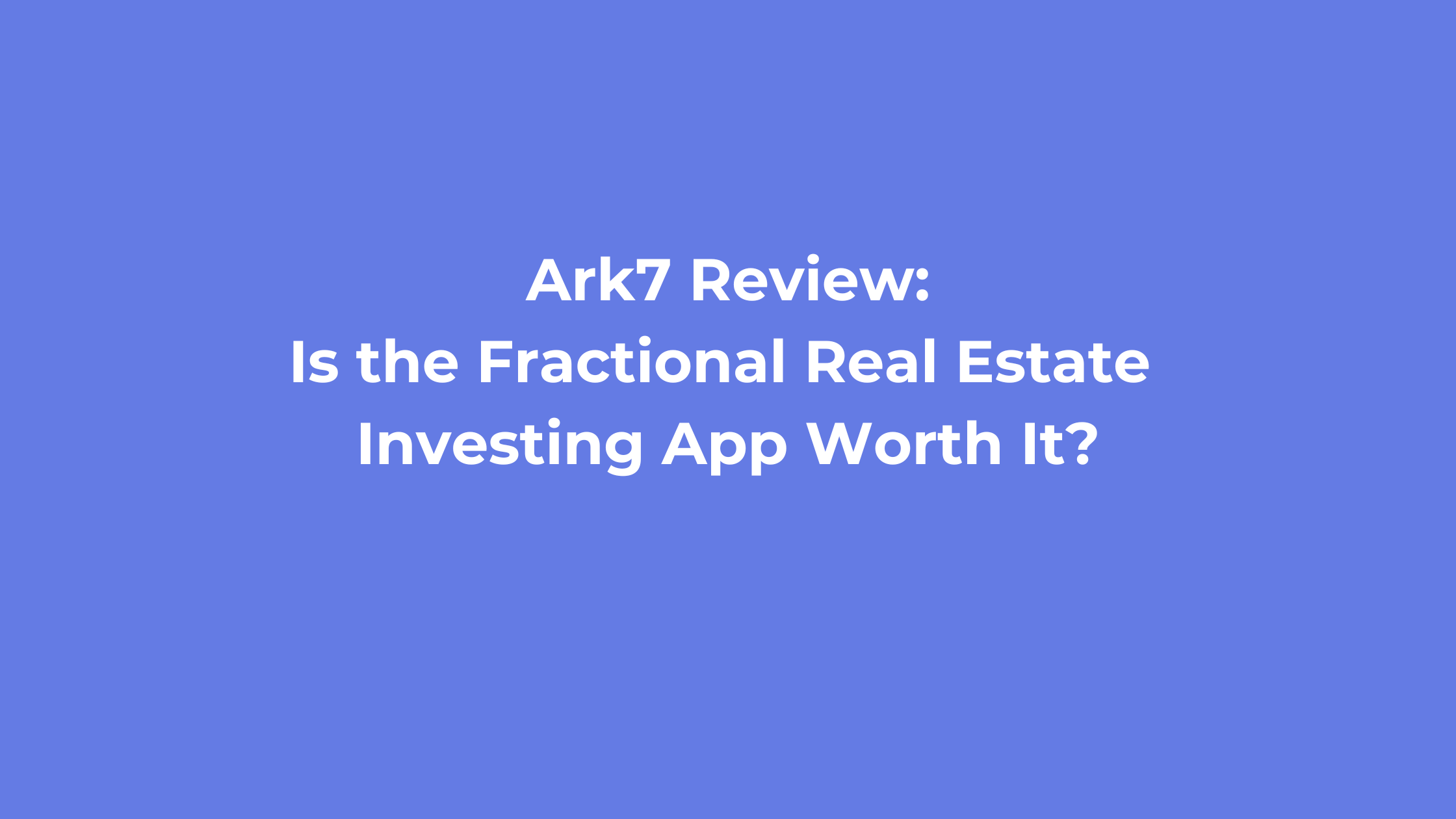Is buying an apartment a good investment? Sure. But buying an apartment building is even better.
Apartment building investing might seem like a really big deal — and it can be, if you’re purchasing the building outright. But few of us can actually do that.
Luckily, there are plenty of ways for investors with smaller accounts to gain access to the world of apartment building investing.
Want to learn more? Keep reading for the ultimate how to buy apartment complex guide. I’ll guide you through everything you need to know about how to invest in apartments, from investing methods to financing options.
I’ll also offer suggestions for accessible ways to gain access to this exciting method of investing at just about any budget level. Keep reading…
At-a-Glance: Our Favorite Crowdfunded Real Estate Platforms
All of these top-rated platforms offer access to commercial real estate, including apartment complexes:
Apartment Building Investing: Is it a Good Idea?
The Bottom Line: Yes. If you learn how to buy an apartment complex, you could potentially set yourself up with a source of passive income for years to come.

Why is it a more financially sound choice than buying a house or land?
As a simple example, consider a huge tract of property in Hickory, North Carolina. It’s unlikely to be more valuable than an apartment building in Noho, Manhattan, in the long term.
But don’t take my word for it. Look at the market patterns:
- Unlike previous generations, millennials and Gen Z are opting to marry, build families, and buy houses later in life. This means a major increase in potential renters.
- Right now, there’s a shortage of affordable housing in most American cities. This is a good thing for owners of apartment complexes that provide affordable to mid-level housing. Renting an apartment is often the most affordable option for many, including young professionals, students, and low-income workers.
With such a large, ready-made target market, apartment building investing is one of the most promising options for real estate investors today. So it’s worth learning how to invest in apartment complexes. Here’s what you need to know…
Is Apartment Building Investing Profitable?
Short answer: yes.
Real estate, in general, can be a profitable investment. But many factors make apartment building investing more profitable than buying a single-family unit:
1. Less risk and a potentially larger return than single-family residences: Apartment buildings are built to maximize profit; the more units in an apartment complex, the higher the potential rental income.
2. Less buyer competition: When buying a house, you compete not only with other investors but also with home buyers looking for living space. With apartment complexes, you just have to compete against other investors.
3. Equity growth: This comes from value appreciation in the long term and rental income in the short term.
4. Leverage: If you borrow $500,000 from the bank at 4% and use it to buy an apartment complex with an 8% cap rate, you can profit from the difference.
5. Tax advantages: Real estate is one of the most tax-advantaged investments. You can depreciate your investments and deduct mortgage interest payments.
Let’s take a look at the numbers.
- According to realtor.com, the average monthly rent in the United States is $1,827 for both apartment complexes and single-family rentals.
- In an apartment with 50 units, if you had a monthly cash flow of $250 out of $1,827 after expenses (maintenance, mortgage, repairs) …Your rental income would be $12,500 per month, as opposed to $250 for a single-family home.
As these numbers demonstrate, owning apartments has the potential to be quite profitable.
Considerations Before Investing in an Apartment Building
Apartment building investing is often considered smart, but is it right for you?

To answer this, let’s first look at the two major investment techniques for how to buy apartment buildings: value-add versus turnkey assets.
Value-Add Properties
Buying Value-Add properties offers a way to build wealth through apartment building investing at a low cost. The only disadvantage is that these properties require extensive and time-consuming refurbishment.
If you choose this option, you’ll spend much time interfacing with property management, contractors, etc. In other words, there is a lot of active upfront work involved before this investment can earn “passive” income.
It’s much like the “buy, renovate, rent, refinance, repeat” strategy for single-family homes, but on a much larger scale.
The main distinction is that when it comes to this form of apartment building investing, the cap rate is a powerful multiplier. If the cap rate exceeds your remodeling costs, you can enjoy a significant value-add to your building.
Turnkey Properties
Unlike value-add apartment complexes, turnkey assets provide a passive revenue stream from the start. You can begin collecting rent from tenants each month as soon as you sign the dotted line.
Long-term, this form of apartment building investing is an excellent way to build equity. But, the returns on investment are not as high as with a value-add property.
That said, you can supply extra services, adjust building expenses, and explore various other methods to boost the building’s net operating revenue and, thus, its value.
How to Buy an Apartment Complex
Learning how to buy an apartment complex isn’t as complicated as you might think.
While the entry barrier may appear to be high because some apartment complexes need down payments of $100,000 or more, there are many financing solutions available that allow you to purchase an apartment with a much lower down payment.
But before we get into financing options, let’s go through a checklist of things to do to make the most of your investment…

1. Set goals and a budget: what is the end goal of your investment? Work backward to determine how much income you need to generate and how much you’re willing to spend as capital.
2. Get clear comparables for rents and sales: unlike single-family homes, apartment complexes are valued primarily on the revenue they provide compared to other apartments in the same area rather than the price of similar recently sold properties. As such, comparables can assist you in determining the market cap rate and net operating income (NOI) — measurements that will allow you to assess the property’s current value and potential ROI.
3. Get pre-approved for financing: Compare the products and rates of at least three lenders. And get pre-approved with at least two lenders so you can get specific quotations to compare once you’ve found the right apartment building to buy.
How to Invest in Apartment Complexes: 6 Best Ways
There are various ways to invest in apartment buildings. Your best option depends on your capital, experience level, investment objectives, and risk appetite. Here are the 6 best ways:
1. Invest Directly
Choosing to invest directly is the most obvious method for how to buy an apartment complex. However, this approach requires a significant amount of upfront capital, especially if you’re in the market for larger apartment buildings with dozens of units and multiple levels.
Additionally, it’s a big job. It involves making numerous decisions and conducting thorough due diligence. To pursue this approach, you’ll need to collaborate with a broker, locate property management, secure a loan … the list goes on.
However, your hard work comes with many benefits, including fewer fees to be paid to a middleman and more control over the property.
2. Crowdfunded Real Estate
Crowdfunded real estate is a low-risk solution for apartment building investing. With this method, you and other investors pool money together to purchase and operate income-generating apartment complexes. Common platforms include Crowdstreet, EquityMultiple, and RealtyMogul.
One disadvantage of this strategy is that you usually enter “blind.” This means you must rely on the fund managers’ knowledge and investing approach. Although you can get details of each property on offer, you have no say in the day-to-day operations of the apartment complex.
However, when considering the low capital requirement, crowdfunded real estate is a realistic apartment building investing approach for those with lower risk tolerance and smaller capital that still offers a potentially consistent return on investment.
3. Invest With a Partner
If you want to invest but want to mitigate risk or simply don’t have enough capital on your own, investing with a partner is a great alternative.
It doesn’t involve as many buyers as crowdfunded real estate, but it still requires less upfront payment on your part. Plus, you still have the ability to make decisions and take an active role in the property’s management.
The main downside of this strategy is that you relinquish some control in exchange. This might not matter for day-to-day management decisions. But when it comes to potential renovations, maintenance, and deciding when to sell, you and your partner may not always agree.
As a best practice, go over everything with your partner beforehand and make sure you’re both on the same page when it comes to big decisions like whether to sell
4. Syndication Agreements
Syndication agreements are very similar to buying an apartment building with a partner. But with this approach, you go into partnership with multiple people instead of one person.
However, unlike a single-person partnership, not all parties in a syndication agreement have decision-making authority.
In syndication agreements, there are two partnership categories:
- General partners, also known as syndicators or sponsors, make all the decisions and actively run the property.
- Limited partners, who are passive investors that only share in income profits.
All parties in a syndication agreement benefit from rental income distributions and potential property appreciation. However, the general partners are in charge of property administration and sale. If everyone agrees on the sponsor’s strategy, this can work out nicely for all parties.
5. Real Estate Funds
Real estate funds are mutual funds or exchange-traded funds (ETFs) that invest primarily in securities offered by real estate corporations. Like other funds of this type, you make a profit by buying appreciating assets (in this case, apartment building complexes).
Some are designed to be passive investments, while others are actively managed. There are private real estate funds that invest in specific apartment complexes, but they often require a more expensive buy-in from investors.
That said, it’s straightforward to get started with real estate funds: all you need is a broker. But you’ll only earn through asset appreciation. So, if fixed income is your goal, this may not be the best choice for you.
6. REITs
REITs (real estate investment trusts) are perhaps the most beginner-friendly apartment building investing approach, especially if your goal is to earn a fixed income.
A REIT is a large corporation that manages apartment complexes and other income-generating real estate properties. When you invest in a REIT, you are purchasing shares in the business that owns and manages the properties rather than the properties themselves.
The main advantage of REITs is that they can generate income. REITs are required by law to provide 90% of their taxable profits to shareholders. Furthermore, because many REITs are publicly traded, you can readily purchase residential REIT shares through an online stock broker.
The only downside of this option is that REITs have lower growth potential than the other apartment building investing options on this list.
This is because REITs must distribute 90% of taxable income back to shareholders, which limits how much capital can be put back into their property portfolio for growth.
Our Top Crowdfunded Real Estate Platforms:
Crowdstreet | EquityMultiple | RealtyMogul | |
Overall Rating: | ⭐⭐⭐⭐⭐ | ⭐⭐⭐⭐ | ⭐⭐⭐⭐ |
Asset: | Commercial real estate | Commercial real estate | Commercial real estate |
Expected Returns: | 12 – 20% | 17% | 6 – 8% |
Minimum Investment: | $25,000 | $5,000 | $5,000 |
Accreditation Requirement: | Accredited only | Accredited only | Accredited and non-accredited |
Final Word: Apartment Building Investing
For many investors, apartment building investing is a smart strategy to develop wealth and create passive income, regardless of your financial goals.
But like any other investment, there is risk associated with apartment building investing. So be sure to weigh the pros and cons of any investment opportunity before moving forward.
If the benefits and potential for passive income are enticing to you, it’s well worth progressing past is buying an apartment a good investment to how to invest in apartments. With so many options available, there are plenty of ways to gain access to the exciting world of multifamily apartment complex investing.
FAQs:
Is investing in apartment building a good investment?
Yes, investing in apartment buildings is generally considered a good investment. They generally offer a much higher return on investment and carry less risk than single-family homes. However, your income potential depends on factors like local real estate trends and rental vs. ownership demand in the area.
Is building an apartment building profitable?
In general, yes. Apartment complexes are built to maximize revenue. The more units and levels you have, the more money you can make.
How to make money with an apartment building?
There are four basic ways to profit from an apartment building. They include leverage, rental income, tax benefits, and growth equity.
How do you evaluate an apartment building investment?
Instead of relying on a single data set to guide estimates, all available data is studied to forecast returns on investment, including comparative market analysis, property revenue analysis, and property expenses.
Where to Invest $1,000 Right Now?
Did you know that stocks rated as "Buy" by the Top Analysts in WallStreetZen's database beat the S&P500 by 98.4% last year?
Our July report reveals the 3 "Strong Buy" stocks that market-beating analysts predict will outperform over the next year.






